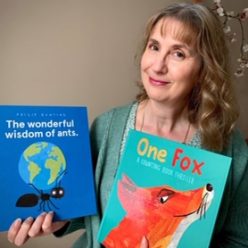Illustrated by the author

Published by Penguin Random House, New Zealand, 2016
You might be more familiar with Lynley Dodd’s wonderful series of picture books about that most loveable shaggy dog called Hairy Maclary and equally adventurous and mischievous cat Slinky Malinki, but here is another sort of tale that involves neither four-legged creature.
The Nickle Nackle Tree can be found in the Manglemunching Forest, it’s full of berries that are as red as red can be and a jumbly jam of birds. How delightful it is to read those rhythmic, opening lines and then discover a whole host of other birds with weird and wonderful names. Have you seen a Ballyhoo bird? What about the Tittle Tattle birds? Or the haughty Huffpuff birds? The colourful, bright illustrations match the descriptive names too, the grouchy Grudge birds don’t look happy at all with their purple feathers, red hawk-nosed beaks and grumpy eyes.
Listening recently to a podcast called The Stubborn Light of Things by Melissa Harrison, author and naturalist, she describes the arrival of the tiny chiffchaff birds to the gentle Suffolk countryside. I had never heard of the chiffchaff bird and looked it up, as one can, on the internet. Not only could I see it, but I could also play the unique song it chirrups and learn about its long migration from Africa.
Lynley Dodd’s whimsically descriptive names for the birds in her picture book brought the chiffchaff bird to mind and made me smile to think that it could also have been included, scratching, itching, and chafing after its long flight!
Other authors like Roald Dahl, Edward Lear, and Dr Seuss have written books and verse with made-up nonsense words. The sound of silly words, the chanting of nonsense rhymes, the conviviality of sharing a secret language, can make a lasting impression on young readers.
I can highly recommend The Nickle Nackle Tree for children 3-8 years, they will love it and learn to count at the same time! Below are more suggestions for picture books which explore the silly side of language:

by Dr Seuss



by Edward Lear
Illustrated by Robert Ingpen

by Edward Lear
Illustrated by Helen Oxenbury





by Roald Dahl
Illustrated by Quentin Blake

Retold by Jane Werner Illustrated by
Walt Disney Studio

by Raymond Briggs

by Shel Silverstein

by Elizabeth Bleumle
Illustrated by Randy Cecil

by Axel Scheffler



by Julia Donaldson
Illustrated by Axel Scheffler

by Robert Vescio
Illustrated by Joanna Bartel




















































































